In an episode of the tortuously funny Channel 4 show Derry Girls, the titular characters find themselves at a Friends Across the Barricade event, where teenagers from both sides of the Catholic-Protestant divide are asked to suggest some things they have in common. What follows instead is this:
I suppose one could say that I do “buzz off” on statues – I’ve written several blog posts on the topic which can attest to that. However, I’ve never properly reflected on where my fascination with the figures comes from. Maybe it’s a trait coded into my Irish Catholic DNA? (Although I am rather freckle-less…)
But I digress… I spent a recent Sunday in Liverpool, with the intent of seeing the Charles Rennie Macintosh exhibit (which I did, and made my thoroughly nostalgic for my home city). However, on my promenade around the city, I encountered a wealth of statues (with some significant female representation to boot!).
Amy Johnson/”Speed”
(One could argue I am perhaps stretching the definition of “statue” with this one, but I will stick to my guns on this.)
The Royal Liver Building, its dual clock towers flanked by the city’s symbol, the liver birds, is perhaps the most iconic buildings in the country. Its neighbour, the George’s Dock Ventilation and Control station, can be easily overlooked. However, this building is of no less importance than the Liver Building. The Mersey tunnel was, at the time of its inception, the longest road tunnel in the world (bested in 1948).
On the waterfront side of the building, there is a figure carved in stone, known as Speed. However, the face on this carving is that of famous female aviator Amy Johnson.
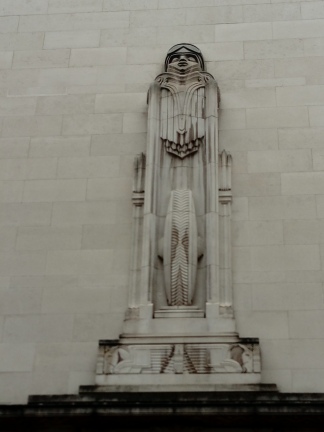
Johnson initially took up flying in the 1929. The following year, she became the first women to fly solo from England to the Australia (setting out on 5th May 1930 and arriving in Darwen, Australia on 24th May, having covered a distance on 18,000 km). She went on to set further aviation records – the fastest trip from the UK to Japan (via Moscow), and the fastest solo flight from London to Cape Town, beating the record previously set up her husband and fellow aviator Jim Mollison.
When the Second World War broke out, Johnson joined the Air Transport Auxiliary, to transport RAF aircraft around the country. Sadly, on 5th January 1941, her aircraft went off course on route to RAF Kidlington during adverse weather. She bailed out as her plane went down in the Thames Estuary, where she sadly died. Her body was never recovered.
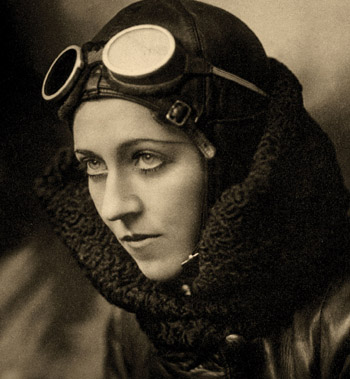
Source: WikiMedia Commons
Incidentally, Amy Johnson also has two statues honouring her, in Hull (near the town of her birth) and Herne Bay in Kent (near the site of her plane crash).
Cilla Black
To those who watched ITV on a Saturday night in the mid-1990s, there is one voice we all instantly recognise: the indomitable Cilla Black. A contemporary of the Beatles, she enjoyed a successful singing career in the 1960s through to the mid 2000s, releasing 13 albums in total. She was also the host of several ITV shows including Surprise Surprise and Blind Date.
Born Priscilla White, her first foray into the entertainment industry came when she took a part-time job working as a cloakroom attendant in the famous Cavern Club.
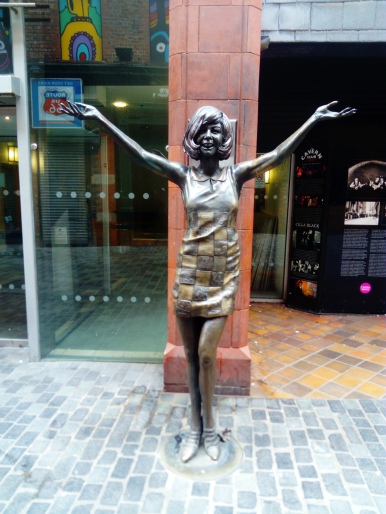
Liverpool is a city with a rich musical tradition – the Beatles, Billy Fury, Frankie Goes to Hollywood, Gerry and the Pacemakers all hail from Merseyside. In 2015, Liverpool was named as a UNESCO City of Music. The city is understandably proud of this heritage, and many of its artists are commemorated in statue form.
Cilla Black’s statue was unveiled in 2017, outside the Cavern Club where her career began. Sadly, she had died two years earlier, and was never able to see this lovely tribute.
Eleanor Rigby
Eleanor Rigby, picks up the rice
In the church where a wedding has been
Lives in a dream
Waits at the window, wearing the face
That she keeps in a jar by the door
Who is it for
In July 1957, two teenage boys met at a church fête for St Peter’s Church in the Liverpool suburb of Woolton. Their friendship and love of music would lead to the formation of one of the most famous and successful bands of all time. The boys were John Lennon and Paul McCartney, and their band needs no introduction.
Interestingly, in the graveyard adjacent to St Peter’s Church, there is a headstone which bears the name of Eleanor Rigby. Her name would become immortalised in The Beatles’ Revolver album. McCartney denied that this was an intentional tribute, although acknowledges that both he and Lennon would take frequent walks through the graveyard, and that the name may simply have been planted in his subconscious from this time. The song is a poignant ode to loneliness.
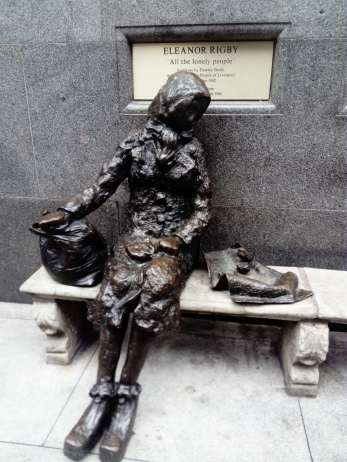
In 1982, a statue known as “Eleanor Rigby” was unveiled on Stanley Street. This depicts a woman sitting alone upon a long bench, with a bag of groceries, a copy of the Liverpool Echo, and only a sparrow for company. The plaque behind her is inscribed thus:
ELEANOR RIGBYDEDICATED TO“ALL THE LONELY PEOPLE…”
Of course, there is ample room on the bench for anyone who wants to keep Eleanor company for a while.
Queen Victoria atop a horse
If a town or city in the UK has only one statue of a woman, there’s a good chance that she’s Queen Victoria. Our previous title holder for longest reigning monarch has over 70 public monuments of some description across the country (and a smattering across the globe in former territories of the British Empire).
Liverpool at least isn’t lacking in female representation on the statue front (and that is without considering the dozens of statues of the Virgin Mary at the city’s many Catholic churches). However, this statue of Queen Victoria outside the St George’s Hall caught my interest.
Most statues of Queen Victoria feature her seated atop her throne, or in a standing position. This is the first I have seen with her seated on horseback, looking very much like a military commander. (Lest we forget all of the unpleasant colonialism of the British Empire, which expanded rapidly during her reign).
Of note, she is paired with her husband, Prince Albert, also atop his horse.
Waiting: A Monument to the Working Horse
In general, statues are made to commemorate specific men and women who have been influential or important in some way to their society (although their actions may be viewed in different lights as time moves on). Then, there are more generalised memorials to groups of people: soldiers, workers, women, whose collective actions helped shaped a moment in history.
Liverpool was one of Britain’s busiest port cities for two centuries, with goods arriving from all over the world. And to move these goods from the dock, required a legion of working horses – up to 20,000 at the peak. This tradition continued up to and including both World Wars.
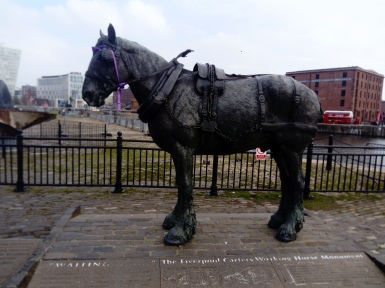
Horses have been a part of human progress for thousands of years – from industry to the armed forces. (The titular character in Shakespeare’s Richard III loudly declares, “A horse, a horse, my kingdom for a horse!” before he is slain in battle). The Liverpool Carter’s Association are determined to keep this part of history alive, and spent more than 10 years raising funds for a monument to their equine colleagues. This statue is called Waiting, and depicts a dock horse ready waiting to set off on their next errand.
This is not the only animal memorial in the UK – as well as Edinburgh’s famous Greyfriars Bobby, London’s Hyde Park is home to the Animals in War Memorial.
Of course, these are but a smattering of Liverpool’s many statues and monuments. The Liverpool Echo published an article in 2016 which points to many other statues of women within the city, some of which I hope to see on my next visit across the Mersey.


Nice post. I’ve only started watching Derry Girls this week and it’s brilliant on many levels.
Liverpool is a great city. I particularly like the Eleanor Rigby statue.
LikeLiked by 1 person
Thanks. I love Derry Girls!
Liverpool is an amazing city – very beautiful. It reminds me very much of Glasgow in its architecture.
LikeLiked by 1 person
You’re quite right. Liverpool is very Glasgow-like in a lot of ways, from its architecture to its history, outlook, sense of humour and perspective. Also, just watched last episode of current series of Derry Girls. Not embarrassed to say I had a wee lump in my throat.
LikeLiked by 1 person
“Being a Derry Girl… Well, it’s a #@&! state of mind.” 😭
LikeLiked by 1 person
I have never seen ‘Speed’ before so will have to take a look. Amy Johnson looked like a film star! Glad you enjoyed the CRM exhibition. My favourite exhibit was the exquisite blue Chinese-style dining arrangement.
LikeLiked by 1 person
Thanks for reading. I love The May Queen by Margaret MacDonald Macintosh in particular
LikeLiked by 1 person
Victoria is on horseback in George Square in Glasgow! Interesting collection of statues. The Mackintosh exhibition is, I think, the same one we had in Kelvingrove. It was so good I meant to go again but time ran out on me, as it does.

LikeLiked by 1 person
You know, I was convinced I’d seen one elsewhere, but Google was totally unhelpful so I assumed I’d imagined it! Thank you for proving I’d not lost my mind! Although I feel that I’ve lost some Glasgow street cred by forgetting it was in my home city…
LikeLike
We’ll forgive you!
LikeLiked by 1 person
I love statues, and you’ve found some great ones! I never would have known that one was Amy Johnson if you hadn’t told me – it’s not exactly the most flattering portrayal, especially considering how glamorous Amy was!
LikeLiked by 1 person
Thanks. It was actually my husband who found it and told me it was Amy Johnson, so I’m afraid I can’t take the credit for it. Luckily he’s interested in the same architectural quirks as me, so our day trips are always full of detours!
LikeLiked by 1 person
Pingback: Statues, statues everywhere: The mixtape edition | Wednesday's Child
Pingback: Quarterly Digest: April – June 2019 | Wednesday's Child
Pingback: Statues, Statues everywhere! Manchester (vol. 3) | Wednesday's Child